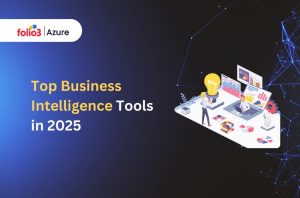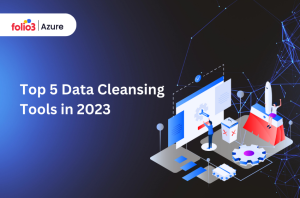Table of Contents
ToggleIn the world of data management and analytics, the term “ELT” often arises as a vital concept. The ELT meaning is simple, Extract, Load, and Transform, but it plays a crucial role in handling and analyzing data for various business needs. In this comprehensive guide, we will explore the meaning of ELT, how it works, its benefits, and its differences compared to ETL (Extract, Transform, Load), along with a look at popular ELT tools, use cases, and how Folio3 can help speed up your data integration process.
How ELT Works

ELT, as the acronym suggests, is a three-step process: Extract, Load, and Transform. Let’s delve into each of these steps to further understand ELT meaning:
- Extract
The first step in ELT involves extracting data from various source systems. These sources can include databases, cloud storage, web services, and more. The data is collected in its raw form, which may not be immediately usable for analysis or reporting.
- Load
The extracted data is then loaded into a centralized data storage system, often a data warehouse or data lake. This storage acts as a repository for all the raw data collected during the extraction phase. The data is preserved as-is, without any major alterations or transformations at this stage.
- Transform
The transformation phase is where the real magic happens. In ELT, data transformation occurs within the data storage system. This process involves cleaning, structuring, and reformatting the data so that it is suitable for analysis and reporting. Transformations can include data normalization, aggregation, joining, and more.
By keeping the transformation step in the data storage system, ELT allows for greater flexibility and scalability in handling data. Users can apply various transformations and build data models as needed, enabling more dynamic and on-the-fly analysis.
Benefits of ELT
ELT offers several advantages that make it a preferred choice for many organizations:
- Scalability
With ELT, data is stored in its raw form, allowing for scalability. You can add new data sources without having to modify the existing data storage infrastructure. This makes ELT well-suited for businesses experiencing rapid data growth.
- Faster Data Processing
ELT enables faster data processing, as data transformation occurs after loading the data into the target system. This improves the overall performance and leads to quicker access to insights and more up-to-date reporting.
- Flexibility
The transformation step in ELT takes place within the data storage system, making it flexible and adaptable. You can easily modify and apply different transformations as your analytics requirements change.
- Time Saving
Since the transformation takes place directly inside the target system, it helps in time saving.
ETL vs ELT: Understanding the Difference
To gain a comprehensive understanding of ELT meaning, it’s essential to differentiate it from ETL (Extract, Transform, Load), a similar data integration process. Here are the key differences between ETL and ELT meaning:
1. Sequence of Operations
In ETL, the data is first extracted, then transformed, and finally loaded into the data warehouse or target system. The transformation step occurs before loading, which can be resource-intensive and time-consuming.
On the other hand, in ELT, data is extracted first, loaded into the data storage system, and transformed afterward. This sequence allows for raw data storage and more flexible transformations.
2. Data Transformation Location
As mentioned, ETL transforms data before loading it into the target system, while ELT transforms data within the storage system. ELT’s in-storage transformation approach offers greater flexibility and real-time data processing capabilities.
3. Tooling and Infrastructure
ETL traditionally requires specialized ETL tools and infrastructure for data transformation. ELT can leverage existing data storage solutions, reducing the need for additional tools and infrastructure.
Top ELT Tools in 2024
Several tools can help implement ELT processes effectively. Since we’ve understood ELT meaning by now, lets looks at some popular options for ELT:
1. Microsoft Azure Data Factory
Microsoft Azure Data Factory is a cloud-based data integration service provided by Microsoft Azure. It allows you to create, schedule, and manage data-driven workflows, including ELT processes, in a scalable and highly available environment.
Microsoft Azure Data Factory provides an option for organizations looking to leverage the Azure ecosystem for their data integration needs.
2. Apache Nifi
Apache Nifi is an open-source data integration tool that simplifies the process of collecting, distributing, and processing data. It supports ELT workflows and offers a user-friendly interface for designing data pipelines.
3. Talend
Talend is a comprehensive data integration platform that provides ELT capabilities. It offers a wide range of data transformation and processing features and supports a variety of data sources.
4. Informatica PowerCenter
Informatica PowerCenter is a robust data integration tool with ELT functionality. It’s known for its data quality and data governance capabilities, making it suitable for complex data integration projects.
Use Cases of ETL for Organizations
ELT can be applied in various scenarios, including:
- Business Intelligence
ELT is a common choice for data warehousing and business intelligence projects. It allows organizations to integrate data from multiple sources, transform it, and provide business users with a unified, easily accessible data repository for reporting and analytics.
- Data Migration
When organizations need to migrate data from one system to another, ELT can be a valuable approach. It enables data extraction, loading, and transformation while ensuring data fidelity during migration.
- Data Integration
ELT is used for integrating data from different departments and systems within an organization. By centralizing data in a data warehouse, businesses can break down data silos and enable better decision-making.
How Folio3 Can Speed Up your Data Integration
Folio3 is a trusted partner that can accelerate your data integration and ELT processes. With a proven track record in data integration, Folio3 offers a range of services and solutions to streamline your data management efforts. Some key ways Folio3 can help include:
- Custom Data Integration Solutions
Folio3 can design and develop custom data integration solutions tailored to your specific needs. These solutions can address the unique challenges and requirements of your business.
- Data Migration Expertise
If you’re planning a data migration project, Folio3’s expertise can ensure a smooth transition with minimal disruptions. They can handle the extraction, loading, and transformation of data, ensuring data integrity throughout the process.
- ELT Implementation
Folio3 has experience in implementing ELT processes using leading tools and technologies. They can help you make the most of ELT’s advantages, such as real-time data processing and scalability.
In conclusion, ELT, meaning Extract, Load, and Transform, is a data integration process that has gained popularity for its flexibility, scalability, and real-time data processing capabilities. It differs from ETL in its sequence of operations and data transformation location, making it a valuable option for various use cases, including business intelligence, data migration, and data integration. Additionally, there are several ELT tools available, and partnering with experts like Folio3 can accelerate and optimize your data integration efforts, ensuring you make the most of your data for informed decision-making and business growth.


